
Berberis repens commonly known as creeping mahonia, creeping grape holly, or creeping barberry, is a species of Berberis native to most of the western United States and two western provinces of Canada. It is low growing shrub that spreads by underground stems. As a species it is well adapted to fire and is a very common understory plant in western forests. An evergreen species, it provides food to deer and elk in winter and can make up a significant part of their diet. The berries are eaten by birds and small mammals, aiding it in spreading to recently disturbed areas. It has found use as a xeric ornamental plant and has escaped from cultivation in areas beyond its native range.
Melicope paniculata, the Lihue melicope, is a rare species of tree in the family Rutaceae. It is endemic to the Hawaiian Islands. Like other Hawaiian Melicope, this species is known as alani.
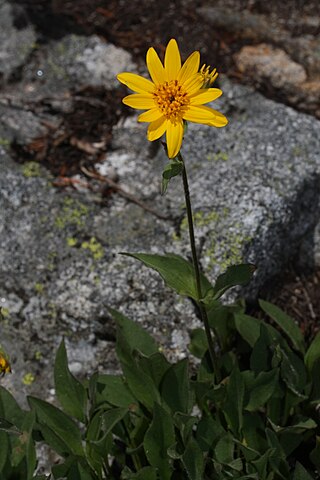
Arnica mollis, the soft arnica or hairy arnica, is a perennial herbaceous flowering plant in the family Asteraceae. It is native to Canada and the United States. There may be a disjunct population of this species in Coös County, New Hampshire. The species grows in subalpine mountain habitat such as meadows and streambanks.
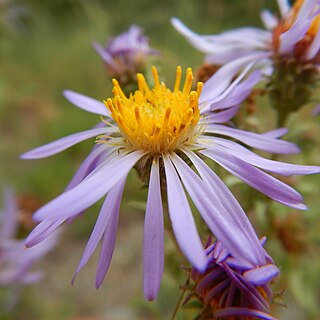
Symphyotrichum campestre is a species of flowering plant of the family Asteraceae commonly known as western meadow aster. It is native to much of western North America where it grows in many habitats, generally at some elevation.

Blitum nuttallianum, is a species of flowering plant in the amaranth family known by the common names povertyweed and Nuttall's povertyweed. It is native to North America, where it is widespread and common from Alaska to Mexico to New England. It can be found in many types of habitat, including disturbed areas, often favoring wet places. It is a fleshy annual herb producing two or more erect, reddish, hairless stems up to about 40 centimeters tall. The thick lance-shaped or arrowhead-shaped leaves are up to 4 centimeters in length. Clusters of several rounded flowers each appear in the leaf axils and yield small fruits about 2 millimeters wide.

Penstemon albomarginatus is a rare species of penstemon known by the common name white-margined penstemon. It is native to the deserts of southern Nevada, western Arizona, and southern California.
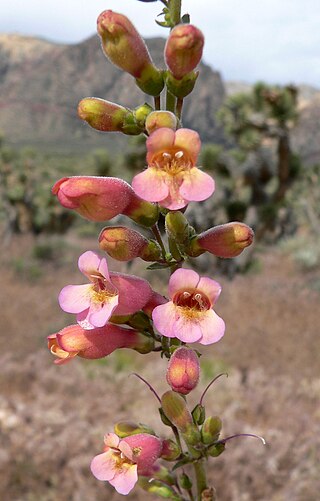
Penstemon bicolor is a species of penstemon known by the common name pinto penstemon. It is native to the desert mountains and valleys of southern Nevada, eastern California, and western Arizona, where it grows in scrub, woodland, and other local habitat. It is a perennial herb which may exceed one meter in maximum height.

Penstemon deustus is a species of penstemon known by the common names hotrock penstemon and scabland penstemon. It is native to much of the northwestern United States from the Pacific Northwest to Wyoming, where it grows in many types of forest and open plateau habitat, often on soils heavy in volcanic rock or on limestone outcrops.

Penstemon grandiflorus, known by the common names shell-leaved penstemon, shell-leaf beardtongue, or large-flowered penstemon, is a tall and showy plant in the Penstemon genus from the plains of North America. Due to its large flowers it has found a place in gardens, particularly ones aimed at low water usage like xeriscape gardens.
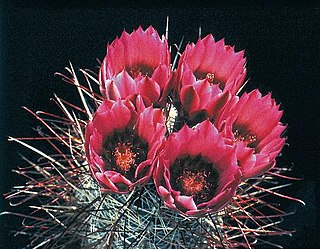
Sclerocactus polyancistrus, the Mohave fishhook cactus or redspined fishhook cactus, is a species of flowering cactus in the genus Sclerocactus. It is found in the Mojave Desert in the Southwestern United States.

Castilleja septentrionalis is a species of Indian paintbrush known by several common names, including northern paintbrush, sulfur paintbrush, and pale painted cup. There is taxonomic disagreement as to if it is one species widely distributed in mountain and alpine environments of North America or if there is a second species, Castilleja sulphurea, in the Rocky Mountains.

Spiranthes diluvialis is a rare species of orchid known as Ute lady's tresses. The species name diluvialis means "of the flood". It is native to the western United States, where there are scattered, mostly small occurrences in the states of Colorado, Idaho, Montana, Nebraska, Nevada, Utah, Washington, and Wyoming. Two occurrences were discovered in southern British Columbia in 2006. The plant faces a number of threats to its existence. It is a federally listed threatened species of the United States.

Mentzelia mollis is a species of flowering plant in the Loasaceae known by the common names soft blazingstar, smooth blazingstar, and smooth stickleaf. It is native to the western United States, where it occurs in Idaho, Oregon, and Nevada.

Tetraneuris acaulis is a North American species of flowering plants in the sunflower family. It is known by many common names in English including stemless four-nerve daisy, stemless hymenoxys, butte marigold, and stemless rubberweed.

Dieteria bigelovii, also known as Bigelow's tansyaster or sticky aster, is a North American species of plants in the family Asteraceae.
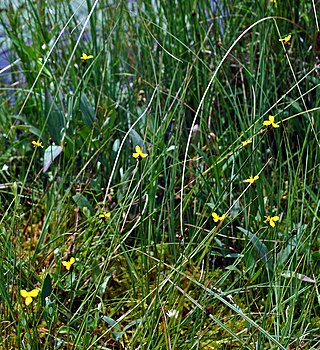
Xyris montana, the northern yelloweyed grass, is a perennial herbaceous flowering plant in the family Xyridaceae. It grows in eastern and central Canada and in the northeastern and north-central United States.
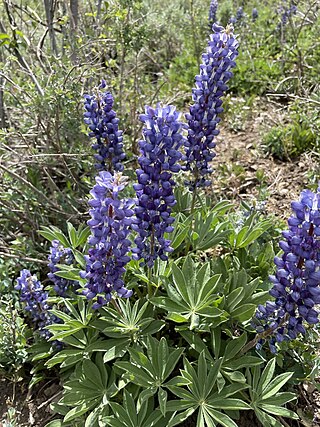
Lupinus prunophilus, commonly known as the hairy bigleaf lupine or chokecherry lupin, is a medium-sized herbaceous plant that grows in the Great Basin and other parts of the U.S. interior between the Sierra-Nevada and the Rockies. It is a close relative and very similar to Lupinus polyphyllus and is considered a subspecies by some botanists.
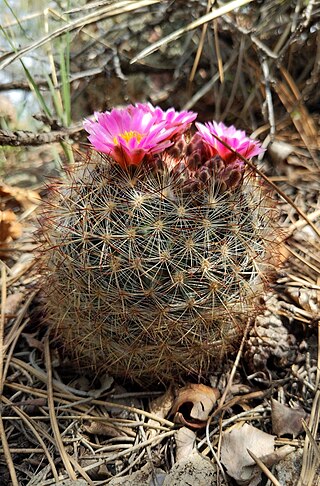
Pediocactus simpsonii, known by the common names mountain cactus, snowball cactus, and mountain ball cactus, is a relatively common cactus that has adapted to survive in cold and dry environments in high elevation areas of the western United States. It can be found at higher elevations than any other cactus in North America. While not a landscape dominating plant, it is a relatively common species and the most common member of the genus Pediocactus. Because of its beauty and adaptation to cold environments it is sometimes grown by gardeners in areas that have few other choices due to the limited number of cactuses with cold adaptations. Like many cactuses its populations are sometimes threatened by this desirability due to the theft or removal of plants from the wild by collectors.

Hypericum scouleri, known by the common name Scouler's St. John's wort in English, is a flowering species of plant from western North America. It grows in areas around streams and wetlands from Canada to the highlands of Mexico. It is sometimes mistaken for the invasive Perforate St John's wort from Eurasia.

Penstemon arenicola, commonly known as Red Desert penstemon, is a species of plant from the Western United States. It primarily grows in Wyoming, but it also grows in small areas of Colorado and Utah. It is a short plant known for growing in sand as referenced by its scientific name.























